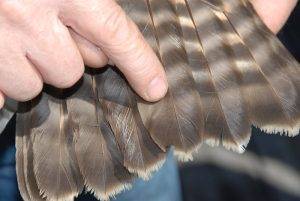Feathers play a vital role in the lives of birds, enabling them to fly, regulate temperature, and even attract mates through vibrant plumage. However, feathers can also reveal essential information about a bird’s health and well-being. One intriguing phenomenon in avian plumage is the presence of stress bars on feathers. In this comprehensive guide, we will explore stress bars on feathers, what they are, why birds have them, and what insights they provide into the lives of our feathered friends.
Understanding Stress Bars on Feathers
Stress bars, also known as stress lines or fault bars, are structural irregularities that occur on individual feathers. They manifest as horizontal bands or lines across the width of a feather’s vane (the flat part of the feather). These lines are often visible to the naked eye, and their appearance varies depending on the severity of the stress.
Causes of Stress Bars on Feathers
Stress bars form as a result of various stressors and challenges that a bird experiences during feather growth. Some common causes include:
- Nutritional Deficiencies: Inadequate nutrition can lead to stress bars. Birds require a balanced diet to produce healthy feathers.
- Disease or Illness: When a bird is unwell, it may divert resources away from feather growth, resulting in stress bars.
- Environmental Stress: Factors such as extreme weather conditions, habitat disturbances, or exposure to toxins can induce stress bars.
- Molting: Stress bars can occur during the molting process, especially if a bird is dealing with additional stressors at the same time.
- Injury or Trauma: Physical injuries or trauma during feather development can lead to stress bars on new feathers.
Appearance of Stress Bars
Stress bars can vary in appearance and severity. In mild cases, they may be subtle, resembling faint lines or slightly darker bands on the feathers. In more severe instances, stress bars can be wider, more prominent, and easily visible. The location of stress bars on a feather can also differ, appearing on the distal (outer) or proximal (inner) portions of the vane.
Role of Feather Growth in Stress Bars
To understand why stress bars form, it’s essential to grasp the process of feather growth. Feathers grow from feather follicles located beneath the skin. As a feather develops, it goes through several stages, including the formation of the calamus (the hollow part of the feather shaft) and the vane. Stressors or disruptions at any stage can result in stress bars.
Significance of Stress Bars
Stress bars on feathers provide valuable insights into a bird’s life and experiences. They serve as a record of past challenges and can be used by researchers and bird enthusiasts to gain a deeper understanding of a bird’s history. Some key insights offered by stress bars include:
- Health Indicators: The presence of stress bars can indicate that a bird has experienced health issues or nutritional deficiencies in the past.
- Environmental Clues: Stress bars can be linked to specific environmental stressors, such as severe weather events or habitat disruptions.
- Recovery and Resilience: If a bird has stress bars but appears healthy, it demonstrates the bird’s resilience and ability to overcome challenges.
- Life History: By studying stress bars on feathers, researchers can learn about a bird’s life history, including periods of stress and recovery.
Mitigating Stress for Birds
Bird enthusiasts can play a role in mitigating stress for their feathered friends. Providing a well-balanced diet, a safe and comfortable environment, and regular veterinary care are essential steps in maintaining a bird’s health. Reducing exposure to environmental stressors, such as extreme temperatures or toxic substances, can also help prevent the formation of stress bars.
What Are Stress Bars on Feathers
Stress bars on feathers are a valuable tool in avian research and conservation efforts. Scientists can study stress bars to assess the impact of environmental changes, habitat loss, and climate variations on bird populations. By understanding how stress bars relate to specific stressors, researchers can work to protect and conserve bird species more effectively.
Frequently Asked Questions (FAQs)
Are stress bars on feathers permanent?
Stress bars are not permanent and will gradually disappear as the bird molts and grows new feathers. Molting allows birds to replace damaged or worn feathers with healthy ones.
Can stress bars be a sign of chronic stress?
Yes, in some cases, the presence of chronic stress can lead to the formation of stress bars. Chronic stressors, such as ongoing habitat disturbances, can affect feather development over an extended period.
Do stress bars affect a bird’s ability to fly?
Stress bars may slightly affect a feather’s structural integrity, but in most cases, they do not significantly impact a bird’s ability to fly. Feathers are resilient and can still function well despite stress bars.
Can stress bars be prevented?
Preventing stress bars involves providing optimal care, nutrition, and a stress-free environment for your bird. Regular veterinary check-ups and prompt treatment of any health issues are essential steps in prevention.
Related Post:
Unlocking the Mysteries of Duck Egg Laying: How Often Do Ducks Lay Eggs?
When Do Ducks Start Quacking? Unraveling the Quack-tastic Mystery
Exploring the Enigmatic Ancona Duck: A Quirky, Beautiful, and Versatile Breed
Stress bars on feathers are fascinating indicators of a bird’s past challenges and experiences. They form in response to various stressors, including nutritional deficiencies, disease, environmental stress, injury, or trauma. While stress bars are not permanent and will disappear with molting, they provide valuable insights into a bird’s health and life history. By understanding the significance of stress bars, bird enthusiasts can take steps to ensure the well-being of their feathered companions and contribute to avian research and conservation efforts.




